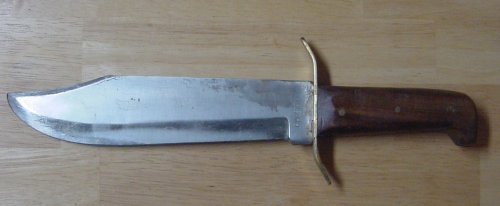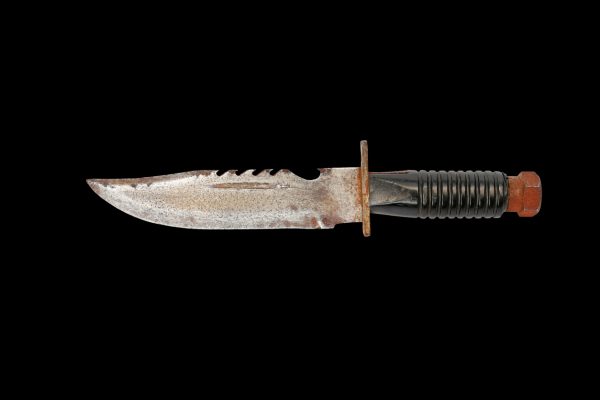Ancient Weapons – Colonel Bowie’s Knife

As firearms became more common and popular, one of the casualties was the sword. While swords still existed, they were no longer in common use. The single-shot rifles and pistols of the day, however, could leave their owners vulnerable while they reloaded. Something was needed as a secondary weapon for those times when there wasn’t enough time to reload.
The bayonet eventually fulfilled this role. While still an issue item in the armies of the world today, the need for bayonets was much higher during the American Civil War when soldiers were armed with single-shot muskets.
The bayonet didn’t, however, suddenly jump into existence alongside the musket. Instead, there was a considerable amount of time when soldiers, adventurers, and ordinary people had to figure out what to do for themselves. Carrying a full-sized sword, a musket, and maybe a single-shot pistol made for a pretty heavy weapons load, so many people opted for a short sword or even a knife.

The master of this, everyone seems to agree, was Colonel Jim Bowie. His fame with a knife came from his use of one at the Sandbar Fight in 1827. This was an honor duel to which Bowie had been invited as part of the party of one of the duelists. Little did anyone know what that duel would bring.
The two duelists Samuel Levi Wells and Dr. Thomas H. Maddox stood eight paces apart, their left sides facing each other. After missing each other twice with their smoothbore single-shot pistols (not an uncommon occurrence), the two shook hands and called it a day.
While the duelists were satisfied, their entourages were not. Their anger fueled by a number of slights, the two sides started fighting. Bowie drew his knife, which was rather large for the time, and chased after one man, suffering a shot in the chest for his efforts.
Within moments, he was shot twice more and clubbed to the ground. There, he was attacked by two assailants armed with sword canes. Bowie killed both of them, slashing one across the stomach and sinking his knife into the other one’s heart even though he was bleeding from seven wounds.
A Bowie knife – Author: Ark30inf – CC BY-SA 3.0This sealed Jim Bowie’s fame, as well as the fame of the knife he used. From then on, he was known as a famed knife fighter, and his knife became the favored knife throughout the west and in the Civil War.
What Exactly is a Bowie Knife
What we consider to be a Bowie knife today may not look anything like the original. Nobody really knows what the original looked like, although there have been many people who have claimed that they own the original. The modern image of the Bowie is something that has gradually developed over time.

Some have said that any sheath knife made after 1827 up until the end of the 1800s could be considered to be a Bowie. There is some truth in this as they were pretty much all influenced by Jim Bowie’s famous fight. As the Red River Herald of Natchitoches, Louisiana, declared: “all the steel in the country, it seemed was immediately converted to Bowie knives.”
The original knife is believed to have looked much like a large butcher’s knife, but other than it being large with a fixed blade, little is known. Whatever its design was, as it gained in popularity it also morphed into the design we know and love today.
Several distinct characteristics became identified with the Bowie style of knife. Most notable was the shape of the blade, which became a large, wide, thick-bladed, clip-point knife. This design combined a lot of strength with a very sharp point. The clip portion of the back of the blade was often sharpened for fighting so that a cut could be made on the backslash. However, this would have worked against the knife’s secondary use as a skinning knife.
Another important feature of the Bowie was the heavy cross-guard originally intended to help prevent the hand from sliding down onto the sharp blade. This was also useful for catching and blocking an opponent’s blade.
Finally, the classic Bowie had a “coffin-shaped” handle: narrower in the middle than at the ends and with the butt of the handle chamfered like the head end of an old-style coffin.
Some manufacturers added a brass strip along the back edge of the blade covering the potion that was not part of the clip point. This strip of softer metal was intended for catching the blade of an opponent’s knife with the idea of pulling it out of their hand – much like a blade catcher on a short sword. It seems fairly clear that the original design did not have this; nor was it a common option.
The Bowie Knife in Survival
The mystery and romance of the Bowie knife remain today – strong enough that most knife collectors have at least one knife that they consider to be a true Bowie.
This doesn’t, however, mean that it is an ideal survival knife. Most knife experts would tell you that a Bowie knife is actually a very poor knife to use for skinning animals because the blade is too long; you’re better off with a blade that’s three to four inches long.

This isn’t to say that the Bowie is useless in a survival situation. We tend to look for a “one tool” answer to any problem and expect one tool to cover all possible needs – this is what multi-tools try to do – but in reality, there are a lot of different styles of knives because there are a lot of different ways that knives are used.
If you are going to use a knife as one of your primary tools to build a shelter in the wild, a Bowie makes a lot more sense than what you would normally use for skinning. The heft and size of Bowie knives make them almost like a small machete.
This makes them an excellent choice for trimming small twigs and smaller branches off a branch that you are going to use for a tent or lean-to’s ridge pole. It is also big enough for cutting off small branches that will be used for covering that lean-to.
If it comes down to fighting, the Bowie has the advantage of reach over many other types of knives that are designed specifically for fighting. I own several actual fighting knives and none of them have a blade as long as my Bowie. So, in a fight where reach is important (like all knife fights), the Bowie has a distinct advantage.
